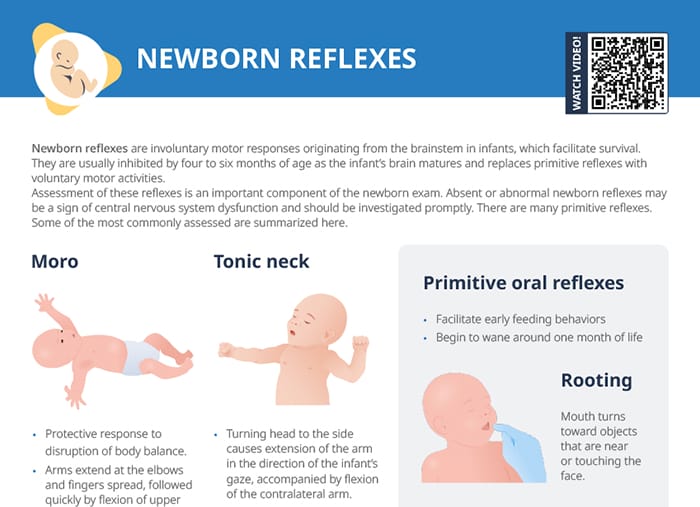Normal deep tendon reflexes
What are deep tendon reflexes?
Deep tendon reflexes are quick muscle contractions in response to a tendon being tapped with a reflex hammer (a sudden stretch in that tendon). These responses are involuntary and automatic.
Normal deep tendon reflexes are an important indicator of a healthy nervous system, particularly the peripheral nerves and spinal cord segments involved in the reflex arcs.
Reflex arcs
The reflex arcs are the pathways the reflexes take from the stimulus to the root nerve.
- The tap with the reflex hammer stretches the tendon.
- The stretch is detected by the nerves in that place, and the signal moves along the nerve to the spinal cord.
- The signal is transferred from the sensory nerve to a motor nerve.
- The motor neurons send the signal back to the muscle.
- The muscle reacts by contracting.
The brain is not involved in this process.
When and why are deep tendon reflexes tested?
Deep tendon reflex assessments test involuntary muscle contractions in response to a stimulus.
They are, for example, performed
- During routine neuro exams
- To investigate neurological symptoms like weakness, numbness
- When spinal cord injury is suspected
- To assess for peripheral nerve damage
- As part of assessments for conditions that can affect nerve function (e.g., diabetes)
Deep tendon reflex tests have a number of purposes:
- Evaluate the functionality of specific spinal cord segments and peripheral nerves
- Aid in the diagnosis of conditions like peripheral neuropathy, MS, spinal cord injury
- Monitor disease progressions
- Detect asymmetries (which can suggest focal neurological issues)
Deep tendon reflexes grading scale
Classifying the responses to reflex tests according to the intensity of the reflex response enables an easy comparison of results between different limbs, sides of the body, and changes over time. The results of deep tendon reflex tests are graded in five stages of response:
- No reflex: possible nerve damage or severe neurological impairment
- Hypoactive: present but weak reflex, suggesting peripheral nerve injury or lower motor neuron disease
- Normal: reflex within normal limits → normal neurological function
- Hyperactive: reflex more active than normal, not necessarily problematic
- Hyperactive with clonus: clonus (repetitive contractions) can suggest upper motor neuron disease or central nervous system pathology.
- Hyperactive with sustained clonus
Reflex hammer: types and uses
Reflex hammer types and uses
A reflex hammer is a medical instrument used by healthcare professionals to test tendon reflexes. Common types of reflex hammers are:
- Taylor reflex hammer: triangular rubber head with flat edge, for general exams
- Buck reflex hammer: often has a removable needle and brush for sensory testing
- Queen square reflex hammer: round, soft rubber head with flexible handle; preferred for its balance
- Babinski reflex hammer: for pediatric examinations
- Tromner reflex hammer: large, flat end and smaller, pointed end; works for superficial and deep reflexes
How to use a reflex hammer
- The client should be relaxed and comfortable.
- The area to be tested should be exposed.
- Hold the hammer by the handle, swinging freely.
- Position the hammer so that it will strike the tendon with a quick, controlled tap.
- Strike briskly, but not forcefully.
- Always compare sides and document the reflex response according to the grading scale.
Biceps reflex
Nerve root
Main spinal nerve roots involved: C5, C6.
Biceps reflex test
- The client’s arm is flexed slightly, palm facing up.
- Hold the arm with your thumb in the antecubital space over the biceps tendon.
- Strike your thumb with the hammer.
Expected result: The arm should flex slightly.
Brachioradialis reflex
Nerve root
Main spinal nerve roots involved: C6.
Brachioradialis reflex test
- The client’s arm is flexed slightly, resting on the lap with the palm facing down.
- Strike the hammer over the outer forearm about 5 cm above the wrist.
Expected result: The palm should turn upward as the forearm rotates laterally.
Triceps reflex
Nerve root
Main spinal nerve roots involved: C7.
Triceps reflex test
- The client’s arm is flexed 90°, with the hand hanging down.
- Support the arm and strike just above the elbow, between the epicondyles.
Expected result: The arm should extend at the elbow.
Patellar reflex
Nerve root
Main spinal nerve roots involved: L4.
Patellar reflex test
- The client’s leg is dangling (if possible).
- Place your hand on one thigh and strike the leg just below the kneecap.
Expected result: The leg should extend at the knee.

![Deep Tendon Reflexes [+ Free Cheat Sheet] | Lecturio Nursing](https://cdn.lecturio.com/assets/Nursing_CS_Deep_Tendon_ReflexesScale-Grading.jpg)